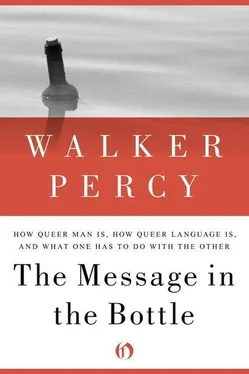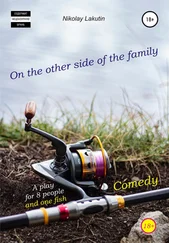We come back to the “right” and “wrong” of blue-dollar hawk and blue darter hawk. Is it proper to ask if the boy’s delight at the “wrong” name is a psychological or an ontological delight? And if the wrong name is cognitive, how is it cognitive? At any rate, we know that the hawk is named for the boy and he has what he wants. His mind, which had really suffered a sort of hunger (an ontological hunger?), now has something to feast on. The bird is, he is told, a blue-dollar hawk. Two conditions, it will be noticed, must be met if the naming is to succeed. There must be an authority behind it — if the boy’s brother had made up the name on the spur of the moment, it wouldn’t have worked. Naming is more than a matter of a semantic “rule.” But apparently there must also be — and here is the scandal — an element of obscurity about the name. The boy can’t help but be disappointed by the logical modifier, blue darter hawk — he feels that although he has asked what the bird is, his father has only told him what it does. If we will prescind for a moment from premature judgments about the “prelogical” or magic character of the boy’s preference, and also forgo the next question, why is it called a blue-dollar hawk? which the boy may or may not have put but probably did not because he knew there was no logical answer the guide could give*—the function of the answer will become clearer. It is connected with the circumstance that the mysterious name, blue-dollar hawk, is both the “right” name — for it has been given in good faith by a Namer who should know and carries an ipso facto authority — and a “wrong” name — for it is not applicable as a logical modifier as blue darter is immediately and univocally applicable. Blue-dollar is not applicable as a modifier at all, for it refers to a something else besides the bird, a something which occupies the same ontological status as the bird. Blue darter tells us something about the bird, what it does, what its color is; blue-dollar tells, or the boy hopes it will tell, what the bird is. For this ontological pairing, or, if you prefer, “error” of identification of word and thing, is the only possible way in which the apprehended nature of the bird, its inscape, can be validated as being what it is. This inscape is, after all, otherwise ineffable. I can describe it, make crude approximations by such words as darting, oaring, speed, dive, but none of these will suffice to affirm this so distinctive something which I have seen. This is why, as Marcel has observed, when I ask what something is, I am more satisfied to be given a name even if the name means nothing to me (especially if?), than to be given a scientific classification. Shelley said that poetry pointed out the before unapprehended relations of things. Wouldn’t it be closer to the case to say that poetry validates that which has already been privately apprehended but has gone unformulated for both of us?
Without getting over one’s head with the larger question of truth, one might still guess that it is extraordinarily rash of the positivist to limit truth to the logical approximation — to say that we cannot know what things are but only how they hang together. The copy theory gives no account of the what we are saying how about. As to the what: since we are not angels, it is true that we cannot know what it is intuitively and as it is in itself. The modern semioticist is scandalized by the metaphor Flesh is grass; but he is also scandalized by the naming sentence This is flesh. As Professor Veatch has pointed out, he is confusing an instrument of knowing with what is known. The word flesh is not this solid flesh, and this solid flesh is not grass. But unless we name it flesh we shall not know it at all, and unless we call flesh grass, we shall not know how it is with flesh. The semioticist leaves unexplained the act of knowing. He imagines naively that I know what this is and then give it a label, whereas the truth is, as Cassirer has shown so impressively, that I cannot know anything at all unless I symbolize it. We can only conceive being, sidle up to it by laying something else alongside. We approach the thing not directly but by pairing, by apposing symbol and thing. Is it not premature to say with the mythist that when the primitive calls the lightning serpentine he conceives it as a snake and is logically wrong? Both truth and error may be served here, error in so far as the lightning is held to participate magically in snakeness, truth in so far as the conception of snake may allow the privately apprehended inscape of the lightning to be formulated. I would have a horror of finding myself allied with those who in the name of instrumentality or inner warmth or whatnot would so attenuate and corrupt truth that it meant nothing. But an analysis of the symbol relation reveals aspects of truth which go far beyond the notion of structural similarity which the symbolic logicians speak of. Two other traits of the thing are discovered and affirmed: one, that it is; two, that it is something.
Everything depends on this distinction between the thing privately apprehended and the thing apprehended and validated for you and me by naming. But is it proper to make such a distinction? Is there any difference, no difference, or the greatest possible difference, between that which I privately apprehend and that which I apprehend and you validate by naming in such a way that I am justified in hoping that you “mean” that very ineffable thing?
For at the basis of the beautiful metaphor — which one begins to see as neither logically “right” nor “wrong” but analogous — at the basis of that heightened sensibility of the poetic experience, there is always the hope that this secret apprehension of my own, which I cannot call knowing because I do not even know that I know it, has a chance of being validated by what you have said.
There must be a space between name and thing, for otherwise the private apprehension is straitened and oppressed. What is required is that the thing be both sanctioned and yet allowed freedom to be what it is. Heidegger said that the essence of truth is freedom. The essence of metaphorical truth and the almost impossible task of the poet is, it seems to me, to name unmistakably and yet to name by such a gentle analogy that the thing beheld by both of us may be truly formulated for what it is.
Blackmur’s and Empson’s examples are better “mistakes” than mine. The street sign in Cambridge, Private Way Dangerous Passing , misunderstood, allowed the exciting possibility that it was one’s own secret forebodings about the little dead-end streets that was meant. But for all of Blackmur’s unsurpassed analysis of this mysterious property of language, I think it unfortunate that he has chosen to call it “gesture,” in view of the semioticist’s use of the word to denote a term in a stimulus-response sequence (i.e., Mead’s “conversation of gesture”) — because this is exactly what it is not. It is a figurational and symbolic import in that sense which is farthest removed from gestural intercourse (such as the feint and parry of Mead’s two boxers). It is, in fact, only when the gesture, word, or thing is endowed with symbolic meaning, that is, united with a significance other than itself, that it takes on the properties which Blackmur attributes to it.
In Empson’s examples, the beauty of the line depends on an actual misreading of what the poet wrote or on a corruption of the spelling. In the former case the poetic instincts of the reader are better than the poet’s. What is important is that the reader’s “mistake” has rescued the poet’s figure from the logical and univocal similarity which the poet despite his best efforts could not escape and placed it at a mysterious and efficacious distance. The remembering of Brooke’s unpassioned machine as impassioned machine is a good example of this. Another is a line of Nash which may or may not have been a mistake. What matters for our purpose is that it could have been.
Читать дальше












